#Sensory Playdate Ideas
Text
Magical Marvel: Unveiling the Wonders of Magic Beadz Jelly Water Beads – Over 20,000 Beads of Enchantment

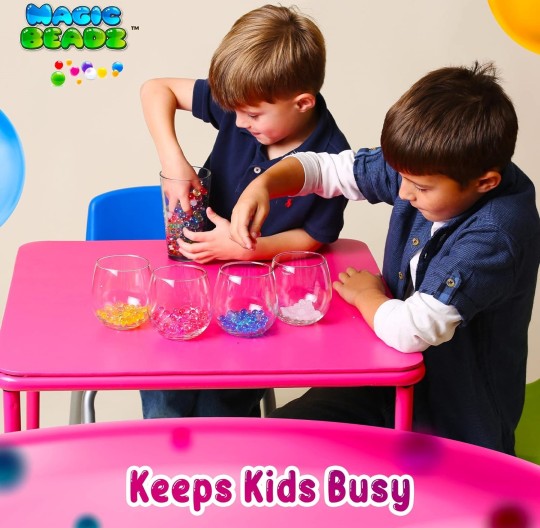
Explore the enchanted wonder that is Magic Beadz Jelly Water Beads! These beads give enchantment beyond belief with over 20,000 beads, diverse sensory enjoyment for all ages, and startling features like biodegradability and aromatherapy play. Discover the realm of DIY innovations, therapeutic relaxation, and unexpected expansion. Ideal for hosting memorable sensory playdates, educational play, and celebrations!"
15 Less Known, Hidden, and Surprising Facts:
Tiny to Mighty: Watch the transformation as Magic Beadz Jelly Water Beads grow many times their original size, turning a handful into an enchanting sea of over 20,000 beads.
Versatile Sensory Fun: These water beads aren't just for kids! Discover how they offer versatile sensory fun for all ages, making them a delightful and engaging experience for everyone.
Dazzling Color Palette: Immerse yourself in a world of color with a vast palette of hues, from vibrant primaries to soothing pastels, creating visually stunning displays as the beads expand.
Long-Lasting Magic: Experience the long-lasting magic as these water beads retain their enchanting size for weeks, providing extended enjoyment and playtime.
Aromatherapy Addition: Infuse a touch of aromatherapy into playtime by adding a few drops of your favorite essential oils to the water, creating a multisensory experience with fragrant beads.
Learning Through Play: These beads aren't just for fun; they're educational too! Engage in counting, sorting, and color recognition activities, turning playtime into a learning adventure.
Biodegradable Beauty: Marvel at the eco-friendliness of Magic Beadz, as they are biodegradable, ensuring that the magic is not only enchanting but also environmentally conscious.
Surprise Expansion: Witness the surprise expansion as the beads grow in unpredictable shapes, adding an element of curiosity and wonder to the enchanting experience.
Unique Party Decor: Elevate your party decor with these magical beads, using them as stunning centerpieces or decor accents, creating an ambiance that captivates guests.
Therapeutic Relaxation: Immerse your hands in the cool, soothing touch of Magic Beadz for a therapeutic experience, promoting relaxation and stress relief for all ages.
DIY Terrarium Delight: Explore the creative side as Magic Beadz become the perfect base for DIY terrariums, adding a touch of enchantment to your miniature garden creations.
Seed Starting Secret: Uncover the gardening secret as Magic Beadz can be used for seed starting, providing a unique and moisture-retaining environment for seeds to sprout and grow.
Non-Toxic Assurance: Ensure safety with the non-toxic nature of Magic Beadz, making them a worry-free option for play and creative exploration.
Home Decor Innovation: Innovate your home decor by incorporating Magic Beadz into vases and bowls, creating stunning displays that add a touch of magic to your living spaces.
Sensory Playdate: Arrange a sensory playdate and share the magic with friends and family, creating a shared experience that fosters creativity, imagination, and laughter.
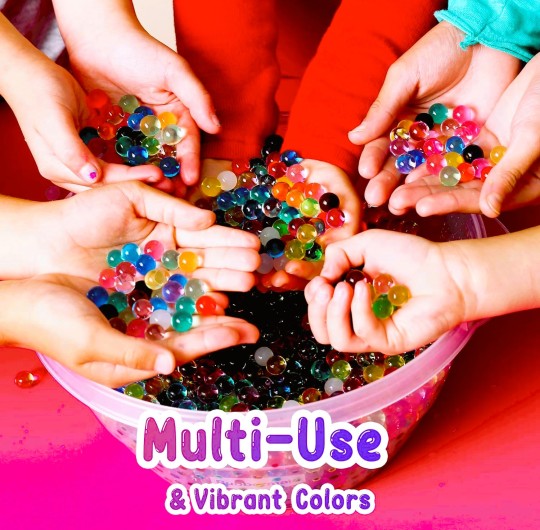
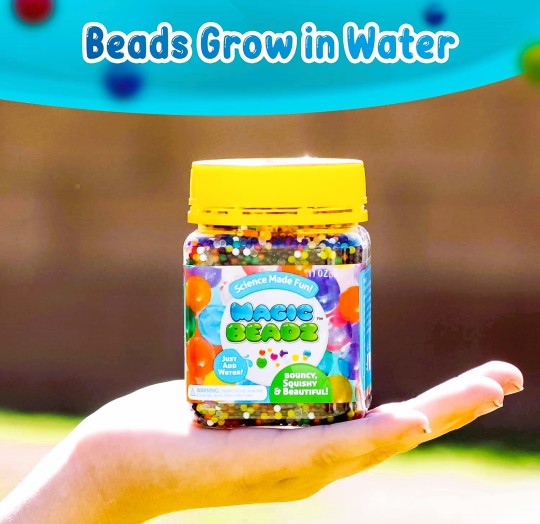
#Jelly Water Beads#Magic Beadz#Sensory Fun for All Ages#Over 20#000 Beads#Biodegradable Water Beads#Aromatherapy Play#Educational Water Beads#Surprise Expansion Beads#DIY Terrarium with Magic Beadz#Non-Toxic Sensory Play#Party Decor with Water Beads#Therapeutic Relaxation Beads#Seed Starting with Magic Beadz#Home Decor Innovation#Sensory Playdate Ideas
0 notes
Text
Some of the reasons I think Stolas is on the spectrum
(finally getting around to popping this on up too).
He has special interests & misses social cues while being happy in them.
It not really normal to be happy reading legal documents when someone's life is on the line. But Stolas is just vibing that he gets to help with his love of words. Yay him!

Stims
He stims when both happy & sad to help regulate his emotions.
His happy stims are:
*clapping when he gets to take Via to the circus, because he thinks they can enjoy it together.
He also does this with contract reading.

*He hopps up and down when his dad gives him a new books. Also when getting ready for his date with Blitz. He's just so happy he needs to hop.


His sad stims:
*are bang his head again and again about the engagement.

*He self sooves with chest strokes when Blitz says his outfit is too much.

*He hand rubs and wringing his hat when worrying about Via in LA.

Special interests
The there's that Stolas info dumps on the playdate with Blitz all about his books and about plants.

Stolas also feels he has to explain why Blitz horse joke was soo funny. And why's it so funny?
Because it's accurate. I love his little cutie.

But he's also kept up his love of plants as a major hobby now he's an adult. When most people tend to swap interests as they age.
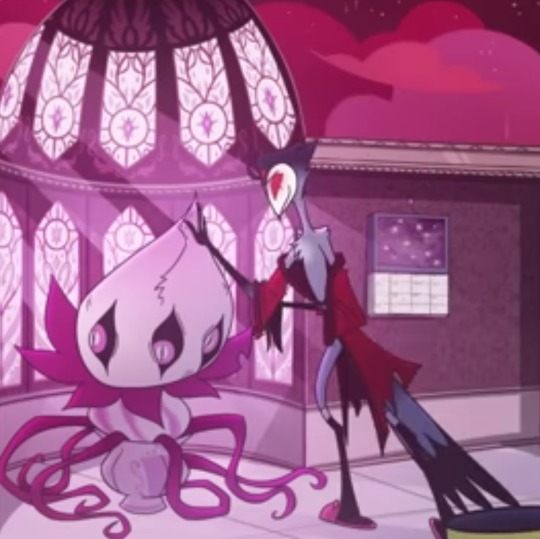
Side bar
His comfy resting hand position is t rex hands. This tends to be an autistic thing. Also works well as an owl.

Sensory issues
Stolas appears to also have some sensory issues too. When his a child he appears to be struggling when Mr Butler touches his hair out of nowhere.

But he's fine with Blitz doing it when they're kissing. This shows a lot of trust between them.

I think it's likely sensory issues are the reason why he swaps into his comfy, very old robe, as often as he can too.

Specific communication issues
While Stolas is very good at some communication styles, he's pretty bad at others.
When the audience think it's another joke about wanting to keep a puppy; he immediately knows Blitz's is panicking the studio. And tries to get to him.

However he doesn't get that his dirty talk is way OTT, because he's mostly likely coping it from the erotica. Not lived experience.

Speaking of erotica.
There's obviously a rule that reading is allowed at the diner table. But Stolas doesn't get This book isn't appropriate to read there.
Another rule he appears to follow more rigidly than most probably would; is that when you get an appointment you wait till you're seen.
Ozzie's ment to met Stolas at noon, but doesn't make it till 4 pm because of problems with work.
Stolas is only a couple of days out of the hospital and is probably feeling horrible.
But he sticks around a minimum of 4 hours to be seen, because he feels he has to.
(I'm assuming he also got taught you turn up earlier rule, but this just a guess).

Stolas genuinely wants to do something Via will enjoy, and he's fine taking Via to stylish occult when she asks.
But didn't get it till she's crying and sad that she wasn't enjoying Loo Loo Land.
"I take it you are.. not having fun." She needs to spell it out. Sarcasm isn't easy for him to interrupt.

His was obviously thought taking his daughter and his lover out to a theme park would be a good way to introduce them.
It's the sort of plot that only works on a novellas. And that's probably when he got it from. (Probably worked great for Gabrielle and Alejandro).

These are examples of him Masking, and not understanding why it didn't work.
Stella's being dangerous to be around = take Via out somewhere for her to have fun to blow off steam.
Wanting your lover and daughter to like eachother = ask IMP to tag along as the completely unnecessary bodyguards.
He doesn't really get that flirty with his affair partner, in front of his kid while going through a divorce isn't a good idea...
He also struggles to understand when his flirting comes off as condescending too. With "ittybity imps like you" or calling him Blitzy in public. He's most likely him coping language from other goeita.
But Stolas is very good at knowing when knowing when Blitz is fine being picked up, when to reassure him with face stokes, or how to calm Blitz down from a panic attack in just a few seconds.
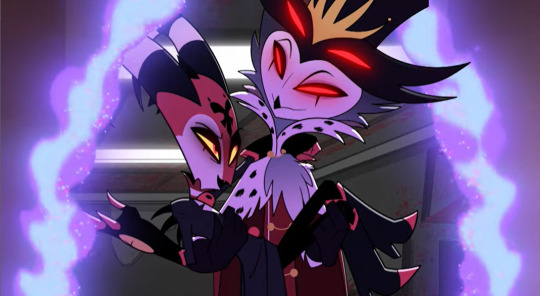


So it's not that he's just never learnt these skills. It's just that some communication skills are harder for him than others.
But if you disagree that fine. 🙂 I just wanted to put down some of my thoughts why I think he could be.
515 notes
·
View notes
Text
me and my puppy made PUFFY PAINT today and painted with it 🎨✨!!!
this was my puppy girl’s idea, they really love touching puffy paintings and puffy stickers (and so do i hehehe) but we had never painted with it before or made it. sooo they brought shaving cream and we used my acrylic paint and some Elmer’s glue to make a BUNCH of fluffy puffy paint!!! it was really fun mixing the paint and watching my baby have fun mixing up all their favorite colors, different purples and blues.. i really love how theirs turned out, it makes me so happy when my little adhd baby has fun with a sensory activity <3 they painted little planets and did a wonderful job !!

I got frustrated with my painting, but I didn’t feel upset long soon after I throw away my painting my baby looks up at me says “look papa im done!” and my mood improves immediately bc oh my god they’re just so lovely, how could I be upset looking at their little shaving cream masterpiece all over their canvas .. and their hands hehe. Then puppy had a good idea that we should do a finger painting together since I didn’t like mine, so we did :D I had lots of fun on my playdate with my little <3


#agere caregiver#caregiver blog#age regression caregiver#caregiver support#sfw caregiver#sfw agere#age regression#age regressor#agere community#agere little#sfw age regression#agere#agere blog#sfw interaction only#agere sfw#agere activities#puffy paint
17 notes
·
View notes
Text
*wanders up to the playground with two toddlers as confused as I am* hey is this the star trek OCs playdate
anyway yeah hi :) I have some pals to introduce
Anna (they/she)
Denobulan-human mixed species
Entomologist (bug science :D)
So so autism
I like making up things about alien beings that canon doesn’t necessarily contradict, so her Denobulan physiology means that the number of times she’s gone hey cool bug :D and got bitten/scratched/stung means she’s become immune to many toxins
has loved Ponyo on the Cliff by the Sea ever since they were little (their human mum showed it to them, probably on a computer screen to keep them entertained, but they kept wanting to watch it again and again) (could probably recite the whole script)
The name Anna was chosen as it’s fairly similar to Denobulan name sounds so easier for their family to pronounce
Regards Anna as their full name (Denobulans don't have surnames)
However being listed in files as Anna [surname, probably Baker or Bryant or something] and as both an English and Denobulan language of some sort native speaker, she gets addressed as [title/rank] [surname] more often than [title/rank] Anna, which would be correct
I couldn’t remember why I liked the idea of a Human-Denobulan mixed character so much but then I remembered the thing that inspired this is the whole sleep thing
(If you don’t know, Denobulans hibernate for a week or so once a year and do not sleep outside that. Humans sleep every 24 hours.)
This ends up meaning this character doesn’t sleep as often as a normal human, but when they do, they are Fast Asleep
So they’re awake for maybe 5 days or so, then simply collapse for a few hours and can function again
I can’t believe I forgot to include this until now, this is such an integral part of this character to me it just feels obvious
They always have their hair in a buzz cut and have done ever since they were old enough to express that their hair being too long caused them discomfort because Bad Sensory. this is 100% because at the time I was first coming up with them my hair was getting too long (it’s usually short but long enough to be curly) and itching my skin and I kept thinking mmmmmm want to cut it all off
I actually renamed her since writing this draft!! they're called Esk now (yes after the Discworld character, long story short her human mum loves Discworld)
Another interest of theirs is baking! Will elaborate on that another time as well
You Love Her. You Have To.
Unnamed (she/her)
Klingon traditional weaponsmith!
Whole Backstory Stuff around how she inherited this
I need to look into both Klingon family stuff and history to find out exactly how this would work but a loose timeline is
Weapon making traditionally not a women’s job (I don’t know if this is accurate to Klingon culture, it genuinely just felt like a good conflict to add)
However smol [unnamed] really wanted to learn from her uncle, so begged and nagged at him until he gave in and taught her stuff
Both verbally bothering him and just constantly being around the workshop, walking there every day, doing the cleaning jobs just to show up and show she was determined
Also necessary to this story is traditional weapon-making methods are dying out, but are preserved in something around a high- or moderately-high-status warrior having their Own Blade, rather than a copy (replicated) or a hand-me-down (unless it’s a very famous one with a great history, though still that might be presumptuous to think you’d live up to that legacy)
This has been her family’s (House’s) traditional job since anyone can remember, but only one lineage had still preserved it
Uncle is training his son to take over, but at some point when [unnamed] has been learning for a little while, this son dies in some sort of battle, leaving her as the only heir to the family’s tradition
From the little I’ve read on Memory Alpha, women couldn’t inherit a House’s title except under special circumstances, so I think she and her uncle will have to fight for her right to inherit the name and lineage
Would probably regard herself as aroace if she had the vocabulary for that, however restoring a dying craft in a remote part of a planet doesn’t leave much time for such questions
Still knows what she wants, has no intention to marry or have children, but to keep the craft being inherited she will adopt someone as a full member of her House who she believes is worthy of carrying on the tradition
This is actually a really interesting point as it shows how she regards the respect and dedication to the craft as making somebody more a part of her House than blood does
There’s a whole loosely defined thing about how she has some distant relatives who want to claim that house’s title despite having been fully prepared to let go of their house’s craftspeople’s legacy
Is actually quite short for a Klingon, maybe 5’4? and also fat and muscular, so she’s still quite a presence
I have got to do more research
(wrote this ages ago and did not post it. also haven't done research. but I want to post my Characters! so here you are :) these are works in progress and I'll keep adding to them but it's nice to get out what I have for now)
#star trek oc#oc esk#klingon oc#denobulan#denobulans#every tag I add means someone might actually see this post#I need them for organisation though#no it's ok I am happy for you to be appreciating my characters! :) I am not scared at all! :)#blorbos from my head#I love them and you will too
11 notes
·
View notes
Note
Hi can you write regressor Ellie with caregiver Tom. The prompt would be that Tom is babysitting Ellie because Gabby had to go out for something, and Tom is taking care of Ellie the whole day while she is very small. It ends with Gabby coming home to find Tom and Ellie sleeping adorably at the couch and she takes a picture.
Regressor! Ellie w/ Caregiver! Gabby & Babysitter! Tom
Gabby rarely left the house without Ellie whenever she’s small. She hated leaving her, but she had some errands that she had to take care of and she wouldn’t be back until after Ellie’s bedtime.
Normally, Gabby would’ve taken Ellie with her, since Ellie barely regressed teeny tiny, but today she did. Which was another reason why Gabby couldn’t take her, as it would be way too obvious that she was acting “strange”.
Luckily though, anytime Gabby had to go somewhere without Ellie or was unavailable, Tom would watch over her.
Tom was actually Ellie’s main babysitter when she’s small. He was always the first person Gabby would call and see if he could watch her. And unless he was busy, Tom always agreed.
Ellie was very comfortable being small around Tom, as he had seen her regressed a lot. Whether it was because he was babysitting her or he had taken Jake over for a playdate, Ellie absolutely loved whenever Tom would come over.
Before Gabby left, she did mention to Tom that Ellie was a lot smaller than usual. Gabby said that she seemed to be around the ages of 1-2 years old, so she was very young.
Tom wasn’t phased at all though, he was used to taking care of younger regressors, so Ellie wasn’t going to be much of a problem for him.
When Tom walked into the living room, he saw Ellie sitting on the floor. There was a light blue blanket underneath her and she had a few toys in arm’s reach.
As soon as Ellie noticed Tom, she stood up and quickly toddled over to him while giggling.
“Tom!” Ellie cheered excitedly, squealing as Tom lifted her up. “Hey, sweet girl! How are ya?” Tom smiled at her as he put her on his hip.
Ellie only kept giggling, which Tom expected. Gabby did say that she was in a very good mood, and that she wasn’t able to talk much. Ellie could say some easy words, but that was about it.
“Tom! Tom!” Ellie happily repeated while pointing at Tom. “Yeah! Tom!” Tom laughed as he pointed to himself, which only made the smaller girl giggle more.
After a few seconds, Ellie began to wiggle around in Tom’s arms, so he set her back down. Ellie went back over to her toys, grabbed one, then went back over to Tom.
Ellie proudly showed Tom her toy, which was the stuffed animal that Gabby had gotten her during All Stars. Ellie absolutely adored the thing, and would always show it off to people multiple times.
Tom let out an overdramatic gasp when Ellie showed him the stuffed animal.
“Who is that, Ellie?” Tom questioned. Ellie giggled and babbled out the name to Tom. If Tom didn’t already know the name, he would’ve had no idea what Ellie was saying.
Another very dramatic gasp left from Tom.
“Is that Mr. Whiskers?!” Ellie squealed, excitedly bouncing a bit while nodding. Very gently, Tom took the plushie away from her.
“Hello, Mr. Whiskers! How are you?” Tom asked the stuffed animal, who obviously said nothing. Ellie was watching Tom interact with the stuffed animal while laughing a lot.
Besides Gabby, Tom was the only person Ellie was fine with when it came to taking a toy away from her, since she knew she’d get it right back. She was well aware that Tom wasn’t going to take her stuffed animal away forever and only did it to be funny.
Tom gave the plush a quick hug, then handed it right back to Ellie. A soft giggle left Ellie, who grabbed Tom’s shirt and pulled him over to the blanket she was originally sitting on.
“Do you want to play, Ellie?” Ellie nodded as she sat down, so Tom did the same. There were mostly some more stuffed animals on the blanket, but the was also a couple sensory toys and a rattle.
Tom grabbed the rattle and shook it for Ellie. She watched this for a few seconds, before giggling and taking the rattle from Tom.
Ellie played with the toy for a couple seconds, then set it down. She grabbed one of her stuffed animals and place it in Tom’s lap.
“Ohh, do you want to play with your stuffies?” Ellie smiled and nodded, so her and Tom played with the stuffed animals.
The two played for a little over an hour, when Tom noticed that Ellie looked a little upset. She had a very small pout on her face.
“What’s the matter, Ellie?” Tom questioned. Ellie made a soft noise and pointed at the kitchen.
“Are you hungry, El? Is it time for your dinner?” Ellie nodded in response. Tom stood up and picked Ellie up from the ground.
“Let’s go see what we can have!” Tom smiled as he took Ellie out to the kitchen.
Tom wasn’t a great cook, but he could make simple things. Like chicken nuggets, mac and cheese, sandwiches, stuff like that.
Tom sat Ellie down on the counter, then searched the freezer to see if they even had chicken nuggets at their house because, if Tom was being honest, he was kinda in the mood for them.
He didn’t find actual chicken nuggets, but he did find a vegan plant based kind, which he assumed Gabby was the one who bought them. Tom looked at the box, then looked over at Ellie.
“Are these even any good?” He asked. His question was answered when Ellie pointed at them.
“Want!” She spoke. “You want these for dinner?” Ellie nodded, so Tom went to get a pan. He put the chicken nuggets on a pan for Ellie, as well as himself, then turned the oven on and placed them in.
“If these are gross, then you’re in big trouble.” Tom teased. Ellie shook her head while giggling. “Nuh-uh!” She said. “Yuh-huh!” Tom playfully argued back.
While the nuggets were cooking, Tom was cutting up some strawberries and putting them on a plate for Ellie. He also put a couple handfuls of pretzels on the plate as well.
Once the chicken nuggets finally finished, Tom cut them up for Ellie and put those on her plate. Tom then picked up Ellie and grabbed the plate, and brought her and her dinner over to the table.
“I’ll bring your juice over in a second, okay?” Tom told her as he placed Ellie down on a chair and set the plate in front of her.
“Sippy?” Ellie asked while looking up at Tom. “You want your sippy?” Ellie nodded. “Mhm.” She hummed. “Alright, I’ll be right back.” Tom smiled, before going over to make Ellie some juice.
Tom got Ellie’s juice ready, then got himself a drink and put the rest of the chicken nuggets on his plate. He brought everything back over to the table.
“Here you go, Ellie! Here’s your juice!” Ellie smiled as Tom set her sippy cup down in front of her.
Tom then sat beside of her, and began to eat his dinner, which he found surprisingly good. He didn’t think he’d like plant based chicken nuggets, but they weren’t bad.
After dinner, Tom grabbed the dishes and started to wash them. While he did the dishes, Ellie went over to him and started tugging on his shirt.
“Play?” She questioned. “Yeah, sweet girl. I’ll play in a few minutes, I just want to get these dishes cleaned.” Tom told her.
“Play!” Ellie repeated, still pulling on Tom’s shirt. “Tom, play!” She squealed.
The entire time Tom did the dishes, Ellie kept tugging on his shirt while repeating his name and the word “play”.
“Alright, Ellie. You want to go play now?” Tom asked while drying off his hands. Ellie happily nodded.
She grabbed Tom’s shirt and led him back to the spot they were playing in a while ago. They played with stuffed animals again, since that’s just what Ellie wanted to do.
Tom played with Ellie for about thirty minutes, until he checked the time. It was 8:30pm, so Ellie’s bedtime was in thirty minutes.
“Hey, Ellie. I think we should start getting you ready for bed.” A pout immediately appeared on Ellie’s face. Tom did his best not to laugh.
“I know, but you gotta get to bed soon.” Tom said. “If you listen and go get in your pajamas, I’ll read you a bedtime story.” Ellie thought about it for a moment, then nodded.
“Up.” She spoke, lifting her arms up so Tom could pick her up. Tom stood from the ground, then grabbed Ellie and carried her to the bedroom so she could get in her pajamas.
Tom got out a onesie for her and helped her change herself since she needed help. Once she was dressed, Tom clipped a pacifier on the onesie and placed it in her mouth. He then grabbed a book, before carrying her out to the living room.
Before they sat on the couch, Tom grabbed Mr. Whiskers for Ellie and gave it to her, causing her to happily hum in response.
Tom placed Ellie in his lap, Ellie immediately curled up with him and looked at the book.
“Do you like this book, Ellie?” Tom asked. Ellie nodded as she cuddled up with her stuffed animal, so Tom began reading the book.
When he finished with the book, Ellie had already fallen asleep. Tom decided to not move Ellie, as he figured Gabby could probably move her to the bed more easily when she came home. Tom didn’t want to wake her up.
So, Tom got on his phone for a while, until his eyes started to feel heavy. He didn’t see any harm in resting them, so that’s what he did.
After an hour, Gabby had finally come home. When she entered the house, it was completely silent, so she assumed Tom had put Ellie to sleep.
She wasn’t totally wrong. Tom had put Ellie to sleep, but he apparently had also put him to sleep since he was asleep as well.
Gabby held back her laughter as she looked at the sight on the couch. Ellie fast asleep on top of Tom, who was also asleep.
Gabby couldn’t help herself but to take out her phone and take a picture of the two. She thought it was adorable and also completely hilarious.
Once she took the photo, Gabby went over to the two and grabbed a blanket off the couch. She put it over them, then gave Ellie a kiss on her head and very gently patted Tom’s head a few times.
#disventure camp agere#total drama agere#fandom agere#agere fandom#agere fic#age regression#disventure camp age regression#total drama age regression
6 notes
·
View notes
Note
hi!! could we get flip!ricky potts and flip!mischa bachinski headcanons? i think they r best bros and would hangout while little too
Yes, the best bros
Flip!Ricky Potts & Flip!Mischa Bachinski Headcannons


These two are most definitely the best of bros when big
But little?
Absolute sibbies
They always want to be together
Playing games, sharing snacks, reading and watching cartoons
Cartoons are an absolute must
Ricky introduced Mischa to a bunch of old 80s and 90s cartoons (He-Man, Shera, The Real Ghost Busters etc.) and Mischa fell in love with them
They spend at least a couple hours watching them every playdate
Mischa also loves reading about and hearing about Zolar from Ricky
(Mischa learned how to sign with the others so he could understand Ricky easier, and so if one of the other littles went nonverbal they could still communicate)
Ricky loves to bounce ideas off of Mischa, he always seems to understand his wild plots
The two usually get up to a little mischief, but most of their time is taken up by playing and watching their shows
They tend to steal treats a lot
When one of the bros is regressed and the other big, they are the coolest older brother ever
Playing pretend, making the little one laugh and giggle through jokes and tickling, helping their brother calm down after a long day
Of course they hit their speed bumps
Ricky gets sensory overload a lot, so school is extremely difficult for him when he regresses
Mischa tries his best to help (always has noise canceling headphones and fidget toys) but sometimes the only thing he can do is find a quiet place for Ricky to sit and unwind
Mischa often struggles with feeling lonely or like a burden when regressed
So Ricky takes extra care to reassure him that he's not a burden and that he loves him and will always be his sibby
Neither of them really have a set age range, so they switch who is the "Older Brother" often
Mischa tends to take on more of a protector role, even when regressed, so Ricky tends to have to help him get calm and not as vigilant when regressed
Mischa's not as big on napping as Ricky is, but he still never minds ending the day with snuggles and a comfy blanket <3
I hope you enjoyed, and thank you for the request!!
#agere#rtc#rtc agere#flip!mischa bachinski#flip!ricky potts#agere headcanons#mischa agere#ride the cyclone age regression#ricky agere#mischa rtc#ricky rtc
25 notes
·
View notes
Text
The Blood Twins
Pronouns while merged: they/them
Bloody: he/him, she/her
Harvest: he/him, they/them

Like the show's original story, BloodMoon was created by Eclipse to serve as his servant/underling. That didn't work out though, because they had their own ideas and weren't about to be told what to do. Eclipse deactivated them and threw their body away.
At least, he thought he deactivated them.
They lived in the basement and the theater for a while until Lunar found them. They immediately adopted him once they learned that Eclipse hurt him too and have been fiercely protective of him ever since. They were able to rescue Moon and Lunar from Eclipse when the time came.
Monty made their body so that they can separate if they want. Harvest is the more 'logical' twin. For the purpose of differentiating between them when necessary, he speaks in italics. Bloody, the more instinctively-driven one, speaks in bold.
Bloody pet regresses, usually a blend between a cat and a dog. Harvest frequently takes care of him. When he can't, Bloody and Lunar have playdates.
The twins both suffer from uncontrollable bloodlust. This is usually satiated by meat and blood they keep in a fridge. When Harvest notices it's running low, though, he'll forgo food for himself and give more to Bloody to keep his brother from losing himself.
Finally, both of the twins suffer from sensory processing (I haven't decided if they have ADHD yet), as well as touch starvation. They'll either sprawl out over Lunar, or Lunar will lay on top of them. The weight is comforting for them.
#lwyd bloodmoon#bloodmoon#bloodmoon twins#harvest#bloody#lwyd bloody#lwyd harvest#tsams agere#reference
11 notes
·
View notes
Text
Autism Awareness Tie-Dye Shirts for Mom and Dad: Showing Support with Style
Tie-Dye the Town with Adorable Autism Pride: Matching Shirts for Mom & Dad

Buy now:19.95$
Rock vibrant colors and celebrate your amazing child with these adorable, tie-dye Autism Mom and Dad shirts! Perfect for spreading awareness and showcasing your love, these shirts come in a variety of splashy, psychedelic tie-dye patterns that are totally unique, just like your child.
Imagine the smiles on your faces as you wear these comfy tees to therapy appointments, park playdates, or autism walks. Made from soft, breathable cotton, they'll keep you cool on sunny days while you cheer on your little one.

Buy now
These shirts aren't just for parents! Grab a set for grandparents, aunts, uncles, or anyone who wants to show their support for autism acceptance. They're also fantastic conversation starters, raising awareness in a fun and positive way.
Available in a range of sizes, you can find the perfect fit for everyone. Plus, with their cheerful tie-dye designs, these shirts are a far cry from boring old awareness tees. Add a pop of color and a whole lot of love to your autism journey with these cute and comfy Mom and Dad shirts!

Buy now
Finding the perfect gift for someone on the spectrum can be tricky. But worry not! Here are some ideas to spark joy and support sensory needs:
Fidget Fun: Fidget toys help manage stress and improve focus. Explore spinners, squishy balls, or calming chewelry.
Sensory Escape: Create a calming haven with a weighted blanket, noise-canceling headphones, or a mesmerizing lava lamp.
Creative Expression: Unleash artistic talent with textured modeling clay, colorful paints, or a light-up drawing pad.
Building Confidence: For puzzle lovers, try a 3D brain teaser or a captivating marble run. Building sets or craft kits encourage creativity and social interaction.

Buy now
Remember, the best gift caters to the individual's unique preferences. Happy gifting!
#Autism Gift Ideas#Tie Dye Autism Apparel#Autism Tie Dye Shirts#Cute Tie Dye Autism Clothing#Tie Dye Autism Mom Apparel#Tie Dye Autism Dad Apparel#Autism Awareness Tie Dye Clothing#Vibrant Tie Dye Autism Gear#Autism Tie Dye Fashion#Communication Aids for Autism#Autism Therapy Tools#Autism-Friendly Gifts#Gifts for Autistic Children#Practical Autism Gifts#Autism Awareness Gifts#Sensory Toys for Autism#View all AUTISM GIFTS products: https://zizzlez.com/trending-topics/hobbies/autism-spectrum-awareness-month/#All products of the store: https://zizzlez.com/
0 notes
Text
What are some ideas for a two year old's birthday party
Planning a birthday party for a two-year-old can be both fun and rewarding. Here are some ideas to consider:

Theme Parties:Choose a theme that the child loves, such as their favorite cartoon character, animals, superheroes, or princesses. Decorate the venue, invitations, and activities according to the theme.
Outdoor Picnic:Organize a picnic in a park or backyard with simple games like sack races, egg and spoon races, or a treasure hunt. Set up picnic blankets and provide finger foods and refreshments for both kids and adults.
DIY Craft Party:Set up craft stations where kids can create simple art projects like finger painting, making bead necklaces, decorating cupcakes, or assembling simple crafts. This allows for creativity and keeps little hands busy.
Animal Encounter:Host a petting zoo or hire an animal handler to bring in some friendly animals for the kids to interact with. Ensure safety measures are in place and that the animals are suitable for young children.
Bouncy House Fun:Rent a bouncy house or inflatable play structure for the backyard. Kids love bouncing and playing, and it's a great way to tire them out while having fun.
Storytime and Puppet Show:Hire a storyteller or puppeteer to entertain the children with interactive stories and puppet shows. This can be both educational and entertaining for the little ones.
Music and Dance Party:Set up a dance floor with age-appropriate music and let the kids dance and groove to their favorite tunes. You can also hire a children's entertainer or a music instructor to lead the party with songs and dance activities.
Sensory Play:Create sensory play stations with activities like a sandbox, water table, play dough, or sensory bins filled with rice, beans, or colored pasta. This stimulates the senses and encourages exploration and discovery.
Character Visits:Hire a costumed character to make a surprise appearance at the party. Whether it's a favorite cartoon character, superhero, or princess, meeting a beloved character can make the birthday celebration extra special.
Simple Indoor Playdate:If the weather doesn't permit an outdoor party, host a simple indoor playdate with age-appropriate toys, games, and activities. Set up play stations with toys like building blocks, puzzles, stuffed animals, and ride-on toys for the little guests to enjoy.
Remember to keep the party short and sweet, as young children have short attention spans. Also, prioritize safety and supervision throughout the event, and don't forget to capture precious moments with plenty of photos and videos!
We're a birthday party entertainment company that aims to make your special day unforgettable for you and your guests. We use our creativity to create a party that goes above and beyond what you expect. We offer fun games like magic shows and temporary tattoos. We believe birthday parties are about bringing people together to remember and enjoy good times. We work hard to create an atmosphere that puts everyone in a great mood.
0 notes
Text
Solo Fatherhood: 10 Engaging Activities for babies 0-3 months

Bringing a newborn into the world is a joyous and transformative experience for parents. During the crucial first three months of a baby's life, it's natural to want to provide the best care and stimulation possible. This comprehensive guide is tailored to parents of infants aged 0-3 months, offering a wealth of valuable insights and activities to foster both growth and bonding.
The journey begins with a focus on the significance of early stimulation. It emphasizes the need for age-appropriate activities that are not only engaging but also promote your baby's development. These activities are designed to enhance their motor skills, cognitive abilities, and emotional growth.
Understanding developmental milestones is essential for every parent. The article dives deep into these milestones, categorizing them into motor skills, cognitive development, and social and emotional growth. These milestones serve as a roadmap for tracking your baby's progress and ensuring they are on the right developmental path.
Sensory play is a fundamental aspect of a newborn's early experiences. The guide explores visual, auditory, and tactile stimulation, offering practical examples and ideas to engage your baby's senses. By incorporating sensory play, you can provide your baby with a rich sensory environment that aids in their cognitive and emotional development.
Establishing a routine is crucial for both you and your baby. It covers sleep schedules, feeding times, and playtime schedules. A well-structured routine can bring a sense of security and predictability to your baby's day while allowing you to efficiently manage your caregiving responsibilities.
Outdoor adventures are encouraged to introduce your baby to the wonders of the natural world. Fresh air benefits, stroller strolls, and garden explorations offer your baby new sensory experiences and help create a sense of connection with the environment.
Reading together with your baby is an invaluable activity that promotes early literacy and nurtures your emotional bond. Age-appropriate books and interactive storytime sessions can be enjoyable and educational for your little one.
The power of music is harnessed in the section on baby-friendly music. Creating a musical environment with soothing tunes and baby-friendly playlists stimulates your baby's auditory senses, creating a calming atmosphere.
Babywearing and skin-to-skin contact are practices that enhance bonding and emotional security. These practices provide numerous physical and emotional benefits for both you and your baby, supporting their overall development.
Sensory bath time is an often-overlooked activity that can be highly enjoyable and beneficial. It promotes bonding through touch, sensory awareness, and relaxation. Gentle bath products and water play can make bath time an exciting and soothing experience for your baby.
Infant massage is a loving practice that offers both physical and emotional benefits. Simple massage techniques can help soothe your baby, improve sleep, and strengthen your bond.
Parent-baby yoga is introduced as a way to strengthen your connection while reaping physical and emotional rewards. Incorporating gentle yoga poses suitable for both you and your baby fosters a sense of togetherness.
Creating a safe environment is vital for your baby's well-being. This section covers baby-proofing basics, safe play areas, and supervision guidelines to ensure your baby's safety as they explore their surroundings.
Monitoring developmental progress is essential to identify and address potential challenges early. Recognizing red flags, regular pediatrician check-ups, and tracking milestones are crucial components of this process.
Playdate ideas are presented as a way to introduce your baby to social interaction. Engaging in playdates with age-appropriate activities and ensuring safety during these interactions contribute to your baby's social development.
Lastly, the article addresses common sleep and feeding issues that parents often encounter. It provides guidance on understanding sleep regression and addressing feeding challenges, emphasizing the importance of seeking support when needed.
In conclusion, these activities and insights are designed to empower parents as they embark on the incredible journey of caring for their newborns. Nurturing a strong foundation of love, learning, and development during these early months will set the stage for a lifetime of growth and cherished memories. Additional resources are offered to provide ongoing support and guidance, making the parenting experience even more rewarding.
For Full Article Check here
0 notes
Text
Homeschool Curriculum for 1-Year-Old: A Comprehensive Guide

Summary: In this comprehensive guide, we will explore various aspects of creating a homeschool curriculum for your 1-year-old, including suggested activities, learning objectives, and frequently asked questions.
Homeschool curriculum for 1 year old can be an enriching experience. At this tender age, your child's brain is like a sponge, ready to absorb knowledge and develop essential skills. Designing a suitable curriculum for your little one requires careful consideration of their developmental needs.
Developmental Milestones:
Understanding your child's developmental milestones is crucial for tailoring a homeschool curriculum. Here are some key areas to focus on:
Cognitive Development:
Stimulate curiosity through sensory experiences like exploring textures, shapes, and colors.
Introduce cause-and-effect toys and activities to foster problem-solving skills.
Encourage language development through talking, reading simple books, and singing songs.
Motor Skills Development:
Promote gross motor skills through activities such as crawling, walking, and playing with balls.
Encourage fine motor skills with activities involving finger painting, stacking blocks, or playing with puzzles.
Social and Emotional Development:
Arrange playdates or social interactions with other children to develop social skills.
Nurture emotional intelligence through responsive interactions, cuddling, and positive reinforcement.
Suggested Activities:
Engaging lesson plans for 1 year olds can enhance their learning experience. Here are some ideas to incorporate into your homeschool curriculum:
Sensory Play:
Set up sensory bins filled with safe materials like rice, sand, or water for your child to explore.
Provide a variety of textured objects and toys for tactile stimulation.
Music and Movement:
Introduce simple musical instruments and encourage your child to explore sounds and rhythms.
Engage in movement activities like dancing, clapping, and mimicking animal sounds.
Reading and Storytelling:
Read board books with colorful pictures and simple stories to develop language skills.
Incorporate interactive storytelling by using puppets or acting out scenes from the books.
Arts and Crafts:
Encourage creativity through finger painting, playing with playdough, or tearing and gluing paper.
Offer age-appropriate art materials like crayons or large brushes for exploring different mediums.
Learning Objectives:
While formal academics are not the primary focus at this age, incorporating learning objectives can promote overall development. Here are a few examples:
Language Development:
Expand vocabulary through exposure to new words and repetition.
Encourage early language skills like babbling and imitating sounds.
Cognitive Skills:
Foster problem-solving abilities through simple puzzles and shape-sorting toys.
Promote cause-and-effect understanding through toys that make sounds or move when interacted with.
Motor Skills:
Strengthen gross motor skills through activities like crawling, walking, and playing on playground equipment.
Develop fine motor skills through activities like stacking blocks or playing with manipulative toys.
FAQs:
Q1. Is it necessary to follow a strict schedule for a homeschool curriculum for a 1-year-old?
A1. Actually, it is optional to follow a strict schedule. Flexibility is key at this age. Focus on incorporating learning opportunities into daily routines rather than adhering to a rigid timetable.
Q2. How long should each homeschool session be?
A2. Short and frequent sessions work best for young children. Aim for 10-15 minutes of focused learning activities several times a day. However, remember that learning can happen naturally throughout the day as you engage with your child.
Q3. What if my child seems uninterested in certain activities?
A3. One-year-olds have short attention spans, and their interests may vary. If your child loses interest, try different activities or revisit the activity later. Follow your child's cues and adapt accordingly.
Q4. How can I assess my child's progress?
A4. At this age, formal assessments are not necessary. Observe your child's developmental milestones, engagement in activities, and overall growth. Celebrate their achievements and provide a nurturing environment for learning.
Q5. Can I incorporate technology or screen time into the homeschool curriculum for my 1-year-old?
A5. It is generally recommended to limit screen time for children under the age of 2. Instead of relying on technology, focus on hands-on, sensory-rich activities that promote active engagement and interaction with the environment. However, some educational apps or interactive digital resources specifically designed for young children can be used sparingly and under supervision.
Conclusion:
Designing a homeschool curriculum for your 1-year-old is an exciting and flexible journey. Focus on their developmental milestones, incorporate engaging activities, and create a nurturing environment that fosters their growth. Remember to adapt the curriculum based on your child's interests and cues. Enjoy this precious time of discovery and learning with your little one!
0 notes
Text
Character Bio: Peni Parker (SP//dr)
Name: Peni Parker
Hero Alias: SP//dr
Bio:
Let’s do this one last time.
Peni Parker was born on October 15th, 3132, to Richard Parker, the first SP//dr, and New York City chief of police Yuriko Watanabe, the latter of whom died shortly after giving birth. Being the daughter of SP//dr, and all that came with it, defines her life. From a young age, Peni had little opportunity to actually bond with her father. He made sure she was well-fed, had a roof over her head, and fixed her boo-boos, but he was always too busy defending the city to really BE with her. Part of why the kid got into robotics and science was to try to bond with her dad, to give them something to talk about. School has never been an issue for her, with her regularly acing her classes. As the daughter of a celebrity (most superheroes are idolized in this world, and SP//dr, New York City’s finest outside the police, is no exception), she always attended private schools with enough protection to make villains think twice about trying to attack her to get to SP//dr. There’s also the fact that most people only want to befriend her for the clout, but that’s a story for another day. She isn’t necessarily friendless, though. One of her closest friends is Harry Osborn, son of Norman Osborn, CEO of Oscorp and one of her father’s bosses in the SP//dr program. The two of them hung out a lot as kids due to their fathers’ setting them up on playdates while they were busy with Oscorp and SP//dr, and they have been friends ever since. All in all, Peni leads a fairly normal life. However, things change at the ripe age of 9 years old.
Richard Parker was a hero. The guy who was bit by a spider and became the one and only SP//dr. The hero who saved the city again and again. The man who, no matter how many times he got hit, always got back up. But after one too many battles with one Doctor Otto Octavius, he didn’t. Couldn’t. Just like that, the man she wanted so badly to be with was gone, and with him, her world shattered. To say she was heartbroken would be an understatement. The next morning, still raw with grieving, Peni moves in with her aunt and uncle, fellow SP//dr program employees May and Benjamin Parker, but not before they introduce her to a certain opportunity. As it turns out, Peni had the right genetic material to be able to pilot SP//dr, just like her father. And so, May and Ben inform Peni that she’s the only suitable replacement for her father as the pilot. Basically, they tell her “Let this spider bite you and get in the robot, Peni”. In spite of knowing how dangerous it is, how massive the responsibility is, and how great a legacy she’ll need to uphold, she accepts. She lets the spider bite her, forming a psychic link with it and gaining a supportive friend in the process. But there’s one problem: She is nine, and thus has no idea how to actually fight or be a hero. After a few months of training under the tutelage of SHIELD and Daredevil, a friend of her father, and connecting with the other heroes based in New York City, she finally takes the leap of faith and starts her life as SP//dr, the hero of New York City.
Abilities:
Psychic Link: The spider bite granted Peni a psychic link with her spider by essentially setting up a wireless connection between their brains. What this means is that the two have access to one another's brains, including senses, thoughts, memories, emotions, and instincts. However, this isn’t always a good thing. While it does allow the two to share experiences, it also has possible consequences such as sensory overload and mental contamination.
Psychically-Operated Mech: SP//dr, the mech, exists on the bleeding edge of mech control systems. How it works is that the spider is half of the mech’s CPU, and a human pilot can link with the spider and become the other half. For Peni, this means that she can control it in tandem with her spider like it was her own body, with all the relatively enhanced agility and dexterity that entails and few of the harmful side effects normally associated with using brain-computer interfacing to control extra body parts. However, like the psychic link, this comes with consequences, such as mental contamination, sensory overload, and the sensation of damage. With the ability to move the mech like a body comes the ability to use the mech’s senses like her own, which extends to feeling damage like physical injuries. The mech’s armor and coding reduce the sensory data her brain receives, but she still feels pain when hit.
Physical Strength: The mech is capable of lifting and moving approximately 45000 kilograms of mass without risk of critically damaging itself. However, both pilots hold back to preserve the mech’s internals and to avoid collateral damage, such as undue property destruction, injury, or death. Without restraint, the max lifting capacity of the mech has been measured between 60000 and 70000 kilograms.
Webs: SP//dr is capable of shooting webs composed of fluid that solidifies into an adhesive solid in the presence of atmospheric conditions. These webs serve a variety of functions, including but not limited to the mech’s famous web-swinging, incapacitating enemies, and grabbing objects from afar. SP//dr can utilize a variety of varieties of web fluid (with different chemical compositions) for a variety of functions, such as electrocution, bandaging, and temporary welding. However, most webbing breaks down within an hour, the only exceptions being designed to last longer.
Adhesive Limbs: The hands and feet of the SP//dr mech are designed with microscopic, artificial “hairs” that allow the mech to adhere to objects by use of van der Waals interactions.
Magnetic Suspension: SP//dr is equipped with a magnetic suspension system enabling it to manipulate its limbs (as many as eight limbs composed of two or three segments) in ways that would be impossible with a conventional articulation system. However, this does come at the cost of increased power consumption, and the limbs are paralyzed without power.
LCD Screen: SP//dr’s cockpit is headed by a screen with an LCD display allowing the mech to display emoticons to show emotions, messages, visual aids, or other images. However, the screen is more fragile than the rest of the hull.
Hull Durability and Armor: The chassis and limbs of SP//dr are durable and well-armored enough for the mech and pilot to be able to walk away from being struck with a bus without losing function.
Miscellaneous Gadgets: Depending on the need, SP//dr can be outfitted with a variety of tools, such as scanners, enhanced sensors, saws, welding torches, fire extinguishers, and weaponry.
Neurogenetic Technology Compatibility: Peni Parker has the correct set of genes to be able to interface with SP//dr (and other technology by proxy) given the proper apparatus. The effects, in addition to operating SP//dr, consist primarily of limited neural hacking ability and enhanced thinking speed (mostly subconscious), memory backup, as well as other general abilities usually granted by neural cybernetics. Oscorp scientists have noted a similarity to a cyberbrain, except entirely organic.
Spider-Sense: One of the few superpowers not entirely dependent on a giant robot, Peni Parker, the spider, and the robot all have a Spider-Sense. It functions as a general danger sense, allowing them to sense dangers other senses can’t detect and avoid them almost autonomically. It can also detect other Spider-People. However, scientists have noted that the sense sometimes acts in complete defiance of scientific possibility.
Intelligence: Even as a child, Peni Parker was a genius, having been one of the brightest kids in her school, a trait that will only grow with age. However, she isn’t a “Renaissance woman”. She specializes in STEM subjects, most specifically robotics and computers, but would be nowhere near as competent with Shakespeare (unfortunately, still taught in schools) or ancient history. She’s also trilingual, with fluency in English and Japanese and some knowledge of Braille.
Fighting Skills: As part of her training to pilot SP//dr, Peni learned fighting skills to enable her to better fight villains. This included boxing, self-defense, martial arts, firearms training, general combat skills, and enhanced physical condition. Aside from “anime moments”, she isn’t superhuman though, merely an athletic baseline human.
Emergency Response Skills: As another part of her training, Peni received training in responding to a general assortment of emergency situations she’d face during her career as SP//dr, including fire rescue, first aid, and water rescue.
Weaknesses:
Peppermint: Spiders hate peppermint, Peni’s spider is no exception, and the psychic link means that Peni shares that resentment. A sufficient dose of peppermint around an area will make SP//dr run from it, at least temporarily.
Vibrations: One of a spider’s most powerful senses is its ability to detect vibrations. This hypersensitivity can also serve as a weakness, as the psychic link means that if the spider senses a particularly strong vibration (or the mech does through onboard sensors), the feedback would be paralyzing. The effect is like a loud guitar riff being played on an amplifier turned to 11 directly attached to both of one’s ears.
Pesticides: Any pesticides that would affect an arachnid would affect SP//dr, so if the spider gets exposed to (or detects through onboard sensors) any of several pesticides, the mech will flee the area as soon as possible to allow itself to stave off the effects of the pesticide. Onboard filtration systems would and do nullify this weakness, however.
Power Grid:
Intelligence: 3 (Grows to 5)
Strength: 2 (5 in mech)
Speed: 2 (3 in mech)
Durability: 2 (5 in mech)
Energy Projection: 1 (2-3 with specific mech weapons)
Fighting Skills: 1 (Grows to 4)
Additional Trivia:
Ideal English VA: Kimiko Glenn
Ideal Japanese Seiyuu: Rie Takahashi
Peni Parker is a vegetarian (like in the comics). This is due to her finding it weird to eat other animals after psychically linking with SP//dr. Similarly, she has an aversion to any animal products requiring killing the animals. Except for insects for reasons most likely related to the psychic link.
As a consequence of being psychically linked to a spider, Peni is one of the more “spidery” Spider-Heros/Spider-Totems/Spider-People. This means that she has a few additional miscellaneous traits only actual spiders would have.
I’m aware of the Web of Life and Destiny and the supernatural aspect of Spider-Totem powers. Thus, I’m going to leave the balance of technological/scientific power origin versus mystical power origin for you to find out.
The SP//dr program has multiple mechs for various situations. The abilities above mostly refer to the primary mech (The same as ITSV), although some things could change with in-universe time and upgrades.
Peni and her spider use “SP//dr” to refer to the spider, the mech, their hero identity, and the program of which they are a part. Due to the psychic link, they always know what they mean.
I don’t have a section on her personality because that would change a LOT in-universe. She goes through a lot, both good and bad. SP//dr stays a supportive friend though.
The SP//dr program is run by Oscorp under the supervision and oversight of SHIELD and the Commission on Superhuman Activities.
In case you’re wondering, I use “neurogenetic” instead of “psychogenetic” because psychogenetics, the word her comic uses, is actually another world for behavioral genetics, the study of how genes influence behavior. Neurogenetics, however, is the study of how genes affect the function of the nervous system. Thus, considering SP//dr’s control mechanism, “neurogenetics” is a more accurate word.
Also, I apologize for any formatting flubs. I copy pasted this from a Google Doc.
#peni parker#sp//dr#marvel#marvel comics#spiderman itsv#spider man into the spider verse#into the spider verse#spider verse#spiderman#spider man#earth-14512#world building#worldbuilding#cyberpunk#earth 14512
15 notes
·
View notes
Text
🌠 Little Bag Stuff 🌠
Here are some ideas for things to keep in your "little bag"!
A little bag can be a bag you take to an event, playdate, park, to your CGs (or any variant) house, car rides, and anywhere you're going where you need or want these items!
- Little tools (paci, sippy cups, bottle, stim toys)
- Stuffy (can be a small one or medium if it will fit)
- Sensory toys/tools
- Coloring book and/or sketchbook
- Snacks (baby star snacks, goldfish crackers, candy, etc)
- Books (can be manga too!)
- Small blanket (maybe a baby blanket if a regular one won't fit)
- Little journal (and pens or pencils)
- Sticker book
- Lotions/oils/perfumes that make you feel small
- Cute Band-Aids
6 notes
·
View notes
Text
Mental Health Wellness Tips for Quarantine
Sharing a piece a clinical psychologist in my network published.
______________
After having thirty-one sessions this week with patients where the singular focus was COVID-19 and how to cope, I decided to consolidate my advice and make a list that I hope is helpful to all. I can't control a lot of what is going on right now, but I can contribute this.
Edit: I am surprised and heartened that this has been shared so widely! People have asked me to credential myself, so to that end, I am a doctoral level Psychologist in NYS with a Psy.D. in the specialities of School and Clinical Psychology.
1. Stick to a routine. Go to sleep and wake up at a reasonable time, write a schedule that is varied and includes time for work as well as self-care.
2. Dress for the social life you want, not the social life you have. Get showered and dressed in comfortable clothes, wash your face, brush your teeth. Take the time to do a bath or a facial. Put on some bright colors. It is amazing how our dress can impact our mood.
3. Get out at least once a day, for at least thirty minutes. If you are concerned of contact, try first thing in the morning, or later in the evening, and try less traveled streets and avenues. If you are high risk or living with those who are high risk, open the windows and blast the fan. It is amazing how much fresh air can do for spirits.
4. Find some time to move each day, again daily for at least thirty minutes. If you don’t feel comfortable going outside, there are many YouTube videos that offer free movement classes, and if all else fails, turn on the music and have a dance party!
5. Reach out to others, you guessed it, at least once daily for thirty minutes. Try to do FaceTime, Skype, phone calls, texting—connect with other people to seek and provide support. Don’t forget to do this for your children as well. Set up virtual playdates with friends daily via FaceTime, Facebook Messenger Kids, Zoom, etc—your kids miss their friends, too!
6. Stay hydrated and eat well. This one may seem obvious, but stress and eating often don’t mix well, and we find ourselves over-indulging, forgetting to eat, and avoiding food. Drink plenty of water, eat some good and nutritious foods, and challenge yourself to learn how to cook something new!
7. Develop a self-care toolkit. This can look different for everyone. A lot of successful self-care strategies involve a sensory component (seven senses: touch, taste, sight, hearing, smell, vestibular (movement) and proprioceptive (comforting pressure). An idea for each: a soft blanket or stuffed animal, a hot chocolate, photos of vacations, comforting music, lavender or eucalyptus oil, a small swing or rocking chair, a weighted blanket. A journal, an inspirational book, or a mandala coloring book is wonderful, bubbles to blow or blowing watercolor on paper through a straw are visually appealing as well as work on controlled breath. Mint gum, Listerine strips, ginger ale, frozen Starburst, ice packs, and cold are also good for anxiety regulation. For children, it is great to help them create a self-regulation comfort box (often a shoe-box or bin they can decorate) that they can use on the ready for first-aid when overwhelmed.
8. Spend extra time playing with children. Children will rarely communicate how they are feeling, but will often make a bid for attention and communication through play. Don’t be surprised to see therapeutic themes of illness, doctor visits, and isolation play through. Understand that play is cathartic and helpful for children—it is how they process their world and problem solve, and there’s a lot they are seeing and experiencing in the now.
9. Give everyone the benefit of the doubt, and a wide berth. A lot of cooped up time can bring out the worst in everyone. Each person will have moments when they will not be at their best. It is important to move with grace through blowups, to not show up to every argument you are invited to, and to not hold grudges and continue disagreements. Everyone is doing the best they can to make it through this.
10. Everyone find their own retreat space. Space is at a premium, particularly with city living. It is important that people think through their own separate space for work and for relaxation. For children, help them identify a place where they can go to retreat when stressed. You can make this place cozy by using blankets, pillows, cushions, scarves, beanbags, tents, and “forts”. It is good to know that even when we are on top of each other, we have our own special place to go to be alone.
11. Expect behavioral issues in children, and respond gently. We are all struggling with disruption in routine, none more than children, who rely on routines constructed by others to make them feel safe and to know what comes next. Expect increased anxiety, worries and fears, nightmares, difficulty separating or sleeping, testing limits, and meltdowns. Do not introduce major behavioral plans or consequences at this time—hold stable and focus on emotional connection.
12. Focus on safety and attachment. We are going to be living for a bit with the unprecedented demand of meeting all work deadlines, homeschooling children, running a sterile household, and making a whole lot of entertainment in confinement. We can get wrapped up in meeting expectations in all domains, but we must remember that these are scary and unpredictable times for children. Focus on strengthening the connection through time spent following their lead, through physical touch, through play, through therapeutic books, and via verbal reassurances that you will be there for them in this time.
13. Lower expectations and practice radical self-acceptance. This idea is connected with #12. We are doing too many things in this moment, under fear and stress. This does not make a formula for excellence. Instead, give yourself what psychologists call “radical self acceptance”: accepting everything about yourself, your current situation, and your life without question, blame, or pushback. You cannot fail at this—there is no roadmap, no precedent for this, and we are all truly doing the best we can in an impossible situation.
14. Limit social media and COVID conversation, especially around children. One can find tons of information on COVID-19 to consume, and it changes minute to minute. The information is often sensationalized, negatively skewed, and alarmist. Find a few trusted sources that you can check in with consistently, limit it to a few times a day, and set a time limit for yourself on how much you consume (again 30 minutes tops, 2-3 times daily). Keep news and alarming conversations out of earshot from children—they see and hear everything, and can become very frightened by what they hear.
15. Notice the good in the world, the helpers. There is a lot of scary, negative, and overwhelming information to take in regarding this pandemic. There are also a ton of stories of people sacrificing, donating, and supporting one another in miraculous ways. It is important to counter-balance the heavy information with the hopeful information.
16. Help others. Find ways, big and small, to give back to others. Support restaurants, offer to grocery shop, check in with elderly neighbors, write psychological wellness tips for others—helping others gives us a sense of agency when things seem out of control.
17. Find something you can control, and control the heck out of it. In moments of big uncertainty and overwhelm, control your little corner of the world. Organize your bookshelf, purge your closet, put together that furniture, group your toys. It helps to anchor and ground us when the bigger things are chaotic.
18. Find a long-term project to dive into. Now is the time to learn how to play the keyboard, put together a huge jigsaw puzzle, start a 15 hour game of Risk, paint a picture, read the Harry Potter series, binge watch an 8-season show, crochet a blanket, solve a Rubix cube, or develop a new town in Animal Crossing. Find something that will keep you busy, distracted, and engaged to take breaks from what is going on in the outside world.
19. Engage in repetitive movements and left-right movements. Research has shown that repetitive movement (knitting, coloring, painting, clay sculpting, jump roping etc) especially left-right movement (running, drumming, skating, hopping) can be effective at self-soothing and maintaining self-regulation in moments of distress.
20. Find an expressive art and go for it. Our emotional brain is very receptive to the creative arts, and it is a direct portal for release of feeling. Find something that is creative (sculpting, drawing, dancing, music, singing, playing) and give it your all. See how relieved you can feel. It is a very effective way of helping kids to emote and communicate as well!
21. Find lightness and humor in each day. There is a lot to be worried about, and with good reason. Counterbalance this heaviness with something funny each day: cat videos on YouTube, a stand-up show on Netflix, a funny movie—we all need a little comedic relief in our day, every day.
22. Reach out for help—your team is there for you. If you have a therapist or psychiatrist, they are available to you, even at a distance. Keep up your medications and your therapy sessions the best you can. If you are having difficulty coping, seek out help for the first time. There are mental health people on the ready to help you through this crisis. Your children’s teachers and related service providers will do anything within their power to help, especially for those parents tasked with the difficult task of being a whole treatment team to their child with special challenges. Seek support groups of fellow home-schoolers, parents, and neighbors to feel connected. There is help and support out there, any time of the day—although we are physically distant, we can always connect virtually.
23. “Chunk” your quarantine, take it moment by moment. We have no road map for this. We don’t know what this will look like in 1 day, 1 week, or 1 month from now. Often, when I work with patients who have anxiety around overwhelming issues, I suggest that they engage in a strategy called “chunking”—focusing on whatever bite-sized piece of a challenge that feels manageable. Whether that be 5 minutes, a day, or a week at a time—find what feels doable for you, and set a time stamp for how far ahead in the future you will let yourself worry. Take each chunk one at a time, and move through stress in pieces.
24. Remind yourself daily that this is temporary. It seems in the midst of this quarantine that it will never end. It is terrifying to think of the road stretching ahead of us. Please take time to remind yourself that although this is very scary and difficult, and will go on for an undetermined amount of time, it is a season of life and it will pass. We will return to feeing free, safe, busy, and connected in the days ahead.
25. Find the lesson. This whole crisis can seem sad, senseless, and at times, avoidable. When psychologists work with trauma, a key feature to helping someone work through said trauma is to help them find their agency, the potential positive outcomes they can effect, the meaning and construction that can come out of destruction. What can each of us learn here, in big and small ways, from this crisis? What needs to change in ourselves, our homes, our communities, our nation, and our world?
(x)
209 notes
·
View notes
Text
I found this useful.............💗Advice from a psychologist:
After having thirty-one sessions this week with patients where the singular focus was COVID-19 and how to cope, I decided to consolidate my advice and make a list that I hope is helpful to all. I can't control a lot of what is going on right now, but I can contribute this.
Edit: I am surprised and heartened that this has been shared so widely! People have asked me to credential myself, so to that end, I am a doctoral level Psychologist in NYS with a Psy.D. in the specialities of School and Clinical Psychology.
MENTAL HEALTH WELLNESS TIPS FOR QUARANTINE
1. Stick to a routine. Go to sleep and wake up at a reasonable time, write a schedule that is varied and includes time for work as well as self-care.
2. Dress for the social life you want, not the social life you have. Get showered and dressed in comfortable clothes, wash your face, brush your teeth. Take the time to do a bath or a facial. Put on some bright colors. It is amazing how our dress can impact our mood.
3. Get out at least once a day, for at least thirty minutes. If you are concerned of contact, try first thing in the morning, or later in the evening, and try less traveled streets and avenues. If you are high risk or living with those who are high risk, open the windows and blast the fan. It is amazing how much fresh air can do for spirits.
4. Find some time to move each day, again daily for at least thirty minutes. If you don’t feel comfortable going outside, there are many YouTube videos that offer free movement classes, and if all else fails, turn on the music and have a dance party!
5. Reach out to others, you guessed it, at least once daily for thirty minutes. Try to do FaceTime, Skype, phone calls, texting—connect with other people to seek and provide support. Don’t forget to do this for your children as well. Set up virtual playdates with friends daily via FaceTime, Facebook Messenger Kids, Zoom, etc—your kids miss their friends, too!
6. Stay hydrated and eat well. This one may seem obvious, but stress and eating often don’t mix well, and we find ourselves over-indulging, forgetting to eat, and avoiding food. Drink plenty of water, eat some good and nutritious foods, and challenge yourself to learn how to cook something new!
7. Develop a self-care toolkit. This can look different for everyone. A lot of successful self-care strategies involve a sensory component (seven senses: touch, taste, sight, hearing, smell, vestibular (movement) and proprioceptive (comforting pressure). An idea for each: a soft blanket or stuffed animal, a hot chocolate, photos of vacations, comforting music, lavender or eucalyptus oil, a small swing or rocking chair, a weighted blanket. A journal, an inspirational book, or a mandala coloring book is wonderful, bubbles to blow or blowing watercolor on paper through a straw are visually appealing as well as work on controlled breath. Mint gum, Listerine strips, ginger ale, frozen Starburst, ice packs, and cold are also good for anxiety regulation. For children, it is great to help them create a self-regulation comfort box (often a shoe-box or bin they can decorate) that they can use on the ready for first-aid when overwhelmed.
8. Spend extra time playing with children. Children will rarely communicate how they are feeling, but will often make a bid for attention and communication through play. Don’t be surprised to see therapeutic themes of illness, doctor visits, and isolation play through. Understand that play is cathartic and helpful for children—it is how they process their world and problem solve, and there’s a lot they are seeing and experiencing in the now.
9. Give everyone the benefit of the doubt, and a wide berth. A lot of cooped up time can bring out the worst in everyone. Each person will have moments when they will not be at their best. It is important to move with grace through blowups, to not show up to every argument you are invited to, and to not hold grudges and continue disagreements. Everyone is doing the best they can to make it through this.
10. Everyone find their own retreat space. Space is at a premium, particularly with city living. It is important that people think through their own separate space for work and for relaxation. For children, help them identify a place where they can go to retreat when stressed. You can make this place cozy by using blankets, pillows, cushions, scarves, beanbags, tents, and “forts”. It is good to know that even when we are on top of each other, we have our own special place to go to be alone.
11. Expect behavioral issues in children, and respond gently. We are all struggling with disruption in routine, none more than children, who rely on routines constructed by others to make them feel safe and to know what comes next. Expect increased anxiety, worries and fears, nightmares, difficulty separating or sleeping, testing limits, and meltdowns. Do not introduce major behavioral plans or consequences at this time—hold stable and focus on emotional connection.
12. Focus on safety and attachment. We are going to be living for a bit with the unprecedented demand of meeting all work deadlines, homeschooling children, running a sterile household, and making a whole lot of entertainment in confinement. We can get wrapped up in meeting expectations in all domains, but we must remember that these are scary and unpredictable times for children. Focus on strengthening the connection through time spent following their lead, through physical touch, through play, through therapeutic books, and via verbal reassurances that you will be there for them in this time.
13. Lower expectations and practice radical self-acceptance. This idea is connected with #12. We are doing too many things in this moment, under fear and stress. This does not make a formula for excellence. Instead, give yourself what psychologists call “radical self acceptance”: accepting everything about yourself, your current situation, and your life without question, blame, or pushback. You cannot fail at this—there is no roadmap, no precedent for this, and we are all truly doing the best we can in an impossible situation.
14. Limit social media and COVID conversation, especially around children. One can find tons of information on COVID-19 to consume, and it changes minute to minute. The information is often sensationalized, negatively skewed, and alarmist. Find a few trusted sources that you can check in with consistently, limit it to a few times a day, and set a time limit for yourself on how much you consume (again 30 minutes tops, 2-3 times daily). Keep news and alarming conversations out of earshot from children—they see and hear everything, and can become very frightened by what they hear.
15. Notice the good in the world, the helpers. There is a lot of scary, negative, and overwhelming information to take in regarding this pandemic. There are also a ton of stories of people sacrificing, donating, and supporting one another in miraculous ways. It is important to counter-balance the heavy information with the hopeful information.
16. Help others. Find ways, big and small, to give back to others. Support restaurants, offer to grocery shop, check in with elderly neighbors, write psychological wellness tips for others—helping others gives us a sense of agency when things seem out of control.
17. Find something you can control, and control the heck out of it. In moments of big uncertainty and overwhelm, control your little corner of the world. Organize your bookshelf, purge your closet, put together that furniture, group your toys. It helps to anchor and ground us when the bigger things are chaotic.
18. Find a long-term project to dive into. Now is the time to learn how to play the keyboard, put together a huge jigsaw puzzle, start a 15 hour game of Risk, paint a picture, read the Harry Potter series, binge watch an 8-season show, crochet a blanket, solve a Rubix cube, or develop a new town in Animal Crossing. Find something that will keep you busy, distracted, and engaged to take breaks from what is going on in the outside world.
19. Engage in repetitive movements and left-right movements. Research has shown that repetitive movement (knitting, coloring, painting, clay sculpting, jump roping etc) especially left-right movement (running, drumming, skating, hopping) can be effective at self-soothing and maintaining self-regulation in moments of distress.
20. Find an expressive art and go for it. Our emotional brain is very receptive to the creative arts, and it is a direct portal for release of feeling. Find something that is creative (sculpting, drawing, dancing, music, singing, playing) and give it your all. See how relieved you can feel. It is a very effective way of helping kids to emote and communicate as well!
21. Find lightness and humor in each day. There is a lot to be worried about, and with good reason. Counterbalance this heaviness with something funny each day: cat videos on YouTube, a stand-up show on Netflix, a funny movie—we all need a little comedic relief in our day, every day.
22. Reach out for help—your team is there for you. If you have a therapist or psychiatrist, they are available to you, even at a distance. Keep up your medications and your therapy sessions the best you can. If you are having difficulty coping, seek out help for the first time. There are mental health people on the ready to help you through this crisis. Your children’s teachers and related service providers will do anything within their power to help, especially for those parents tasked with the difficult task of being a whole treatment team to their child with special challenges. Seek support groups of fellow home-schoolers, parents, and neighbors to feel connected. There is help and support out there, any time of the day—although we are physically distant, we can always connect virtually.
23. “Chunk” your quarantine, take it moment by moment. We have no road map for this. We don’t know what this will look like in 1 day, 1 week, or 1 month from now. Often, when I work with patients who have anxiety around overwhelming issues, I suggest that they engage in a strategy called “chunking”—focusing on whatever bite-sized piece of a challenge that feels manageable. Whether that be 5 minutes, a day, or a week at a time—find what feels doable for you, and set a time stamp for how far ahead in the future you will let yourself worry. Take each chunk one at a time, and move through stress in pieces.
24. Remind yourself daily that this is temporary. It seems in the midst of this quarantine that it will never end. It is terrifying to think of the road stretching ahead of us. Please take time to remind yourself that although this is very scary and difficult, and will go on for an undetermined amount of time, it is a season of life and it will pass. We will return to feeing free, safe, busy, and connected in the days ahead.
25. Find the lesson. This whole crisis can seem sad, senseless, and at times, avoidable. When psychologists work with trauma, a key feature to helping someone work through said trauma is to help them find their agency, the potential positive outcomes they can effect, the meaning and construction that can come out of destruction. What can each of us learn here, in big and small ways, from this crisis? What needs to change in ourselves, our homes, our communities, our nation, and our world?
Source: Unknown
87 notes
·
View notes
Text
Mental Health Wellness Tips for Quarantine
From Facebook, written by Betsy Williams Briggs
[As an anxious person myself, please note: this is not a list of EVERYTHING YOU SHOULD BE DOING. Pick the things that will help you and let the others go! <3 ]
From a psychologist:
After having thirty-one sessions this week with patients where the singular focus was COVID-19 and how to cope, I decided to consolidate my advice and make a list that I hope is helpful to all. I can't control a lot of what is going on right now, but I can contribute this.
Edit: I am surprised and heartened that this has been shared so widely! People have asked me to credential myself, so to that end, I am a doctoral level Psychologist in NYS with a Psy.D. in the specialities of School and Clinical Psychology.
MENTAL HEALTH WELLNESS TIPS FOR QUARANTINE
1. Stick to a routine. Go to sleep and wake up at a reasonable time, write a schedule that is varied and includes time for work as well as self-care.
2. Dress for the social life you want, not the social life you have. Get showered and dressed in comfortable clothes, wash your face, brush your teeth. Take the time to do a bath or a facial. Put on some bright colors. It is amazing how our dress can impact our mood.
3. Get out at least once a day, for at least thirty minutes. If you are concerned of contact, try first thing in the morning, or later in the evening, and try less traveled streets and avenues. If you are high risk or living with those who are high risk, open the windows and blast the fan. It is amazing how much fresh air can do for spirits.
4. Find some time to move each day, again daily for at least thirty minutes. If you don’t feel comfortable going outside, there are many YouTube videos that offer free movement classes, and if all else fails, turn on the music and have a dance party!
5. Reach out to others, you guessed it, at least once daily for thirty minutes. Try to do FaceTime, Skype, phone calls, texting—connect with other people to seek and provide support. Don’t forget to do this for your children as well. Set up virtual playdates with friends daily via FaceTime, Facebook Messenger Kids, Zoom, etc—your kids miss their friends, too!
6. Stay hydrated and eat well. This one may seem obvious, but stress and eating often don’t mix well, and we find ourselves over-indulging, forgetting to eat, and avoiding food. Drink plenty of water, eat some good and nutritious foods, and challenge yourself to learn how to cook something new!
7. Develop a self-care toolkit. This can look different for everyone. A lot of successful self-care strategies involve a sensory component (seven senses: touch, taste, sight, hearing, smell, vestibular (movement) and proprioceptive (comforting pressure). An idea for each: a soft blanket or stuffed animal, a hot chocolate, photos of vacations, comforting music, lavender or eucalyptus oil, a small swing or rocking chair, a weighted blanket. A journal, an inspirational book, or a mandala coloring book is wonderful, bubbles to blow or blowing watercolor on paper through a straw are visually appealing as well as work on controlled breath. Mint gum, Listerine strips, ginger ale, frozen Starburst, ice packs, and cold are also good for anxiety regulation. For children, it is great to help them create a self-regulation comfort box (often a shoe-box or bin they can decorate) that they can use on the ready for first-aid when overwhelmed.
8. Spend extra time playing with children. Children will rarely communicate how they are feeling, but will often make a bid for attention and communication through play. Don’t be surprised to see therapeutic themes of illness, doctor visits, and isolation play through. Understand that play is cathartic and helpful for children—it is how they process their world and problem solve, and there’s a lot they are seeing and experiencing in the now.
9. Give everyone the benefit of the doubt, and a wide berth. A lot of cooped up time can bring out the worst in everyone. Each person will have moments when they will not be at their best. It is important to move with grace through blowups, to not show up to every argument you are invited to, and to not hold grudges and continue disagreements. Everyone is doing the best they can to make it through this.
10. Everyone find their own retreat space. Space is at a premium, particularly with city living. It is important that people think through their own separate space for work and for relaxation. For children, help them identify a place where they can go to retreat when stressed. You can make this place cozy by using blankets, pillows, cushions, scarves, beanbags, tents, and “forts”. It is good to know that even when we are on top of each other, we have our own special place to go to be alone.
11. Expect behavioral issues in children, and respond gently. We are all struggling with disruption in routine, none more than children, who rely on routines constructed by others to make them feel safe and to know what comes next. Expect increased anxiety, worries and fears, nightmares, difficulty separating or sleeping, testing limits, and meltdowns. Do not introduce major behavioral plans or consequences at this time—hold stable and focus on emotional connection.
12. Focus on safety and attachment. We are going to be living for a bit with the unprecedented demand of meeting all work deadlines, homeschooling children, running a sterile household, and making a whole lot of entertainment in confinement. We can get wrapped up in meeting expectations in all domains, but we must remember that these are scary and unpredictable times for children. Focus on strengthening the connection through time spent following their lead, through physical touch, through play, through therapeutic books, and via verbal reassurances that you will be there for them in this time.
13. Lower expectations and practice radical self-acceptance. This idea is connected with #12. We are doing too many things in this moment, under fear and stress. This does not make a formula for excellence. Instead, give yourself what psychologists call “radical self acceptance”: accepting everything about yourself, your current situation, and your life without question, blame, or pushback. You cannot fail at this—there is no roadmap, no precedent for this, and we are all truly doing the best we can in an impossible situation.
14. Limit social media and COVID conversation, especially around children. One can find tons of information on COVID-19 to consume, and it changes minute to minute. The information is often sensationalized, negatively skewed, and alarmist. Find a few trusted sources that you can check in with consistently, limit it to a few times a day, and set a time limit for yourself on how much you consume (again 30 minutes tops, 2-3 times daily). Keep news and alarming conversations out of earshot from children—they see and hear everything, and can become very frightened by what they hear.
15. Notice the good in the world, the helpers. There is a lot of scary, negative, and overwhelming information to take in regarding this pandemic. There are also a ton of stories of people sacrificing, donating, and supporting one another in miraculous ways. It is important to counter-balance the heavy information with the hopeful information.
16. Help others. Find ways, big and small, to give back to others. Support restaurants, offer to grocery shop, check in with elderly neighbors, write psychological wellness tips for others—helping others gives us a sense of agency when things seem out of control.
17. Find something you can control, and control the heck out of it. In moments of big uncertainty and overwhelm, control your little corner of the world. Organize your bookshelf, purge your closet, put together that furniture, group your toys. It helps to anchor and ground us when the bigger things are chaotic.
18. Find a long-term project to dive into. Now is the time to learn how to play the keyboard, put together a huge jigsaw puzzle, start a 15 hour game of Risk, paint a picture, read the Harry Potter series, binge watch an 8-season show, crochet a blanket, solve a Rubix cube, or develop a new town in Animal Crossing. Find something that will keep you busy, distracted, and engaged to take breaks from what is going on in the outside world.
19. Engage in repetitive movements and left-right movements. Research has shown that repetitive movement (knitting, coloring, painting, clay sculpting, jump roping etc) especially left-right movement (running, drumming, skating, hopping) can be effective at self-soothing and maintaining self-regulation in moments of distress.
20. Find an expressive art and go for it. Our emotional brain is very receptive to the creative arts, and it is a direct portal for release of feeling. Find something that is creative (sculpting, drawing, dancing, music, singing, playing) and give it your all. See how relieved you can feel. It is a very effective way of helping kids to emote and communicate as well!
21. Find lightness and humor in each day. There is a lot to be worried about, and with good reason. Counterbalance this heaviness with something funny each day: cat videos on YouTube, a stand-up show on Netflix, a funny movie—we all need a little comedic relief in our day, every day.
22. Reach out for help—your team is there for you. If you have a therapist or psychiatrist, they are available to you, even at a distance. Keep up your medications and your therapy sessions the best you can. If you are having difficulty coping, seek out help for the first time. There are mental health people on the ready to help you through this crisis. Your children’s teachers and related service providers will do anything within their power to help, especially for those parents tasked with the difficult task of being a whole treatment team to their child with special challenges. Seek support groups of fellow home-schoolers, parents, and neighbors to feel connected. There is help and support out there, any time of the day—although we are physically distant, we can always connect virtually.
23. “Chunk” your quarantine, take it moment by moment. We have no road map for this. We don’t know what this will look like in 1 day, 1 week, or 1 month from now. Often, when I work with patients who have anxiety around overwhelming issues, I suggest that they engage in a strategy called “chunking”—focusing on whatever bite-sized piece of a challenge that feels manageable. Whether that be 5 minutes, a day, or a week at a time—find what feels doable for you, and set a time stamp for how far ahead in the future you will let yourself worry. Take each chunk one at a time, and move through stress in pieces.
24. Remind yourself daily that this is temporary. It seems in the midst of this quarantine that it will never end. It is terrifying to think of the road stretching ahead of us. Please take time to remind yourself that although this is very scary and difficult, and will go on for an undetermined amount of time, it is a season of life and it will pass. We will return to feeing free, safe, busy, and connected in the days ahead.
25. Find the lesson. This whole crisis can seem sad, senseless, and at times, avoidable. When psychologists work with trauma, a key feature to helping someone work through said trauma is to help them find their agency, the potential positive outcomes they can effect, the meaning and construction that can come out of destruction. What can each of us learn here, in big and small ways, from this crisis? What needs to change in ourselves, our homes, our communities, our nation, and our world?
70 notes
·
View notes